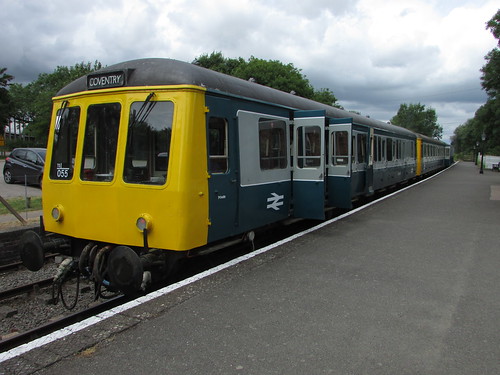
DMU Days at the Battlefield Line: After taking the school party to Shenton on 4th July 2017, the 1-car coupled to the 2-car set wait at Shenton prior to the return to Shackerstone.
In the summer of 2018, these diesel railcars provide the 'Midweek Services' on Tuesdays, Wednesdays and Thursdays so I seem to be getting regular DMU driving turns. I've always enjoyed driving the 'British Railways Modernisation' DMUs, which I remember from my own childhood when they were first introduced but the afflictions of increasing age make a 'diesel day' increasingly attractive for a number of reasons.
Firstly, preparation time is much reduced, compared with steam. 'Checking levels', as on a car, is required but the laborious 'oiling round' is avoided. Whilst a visual examination around the underframe is essential, once the engines are started, also from ground level, the driver can return to the cab whilst the compressors establish sufficient control air pressure to allow movement.
Secondly, driving is carried out whilst seated. Whilst I don't find the seat design particularly good (and manoeuvring around it is tight), it represents luxury compared with most steam locomotives which either make no provision for sitting or offer a rather mean wooden tip-up seat. Gresley is renowned for fitting a padded leather bucket seat on some of his steam locomotives. On most designs, many drivers (the writer included) preferred to remain standing to make the most of the poor forward vision offered by the cab design.
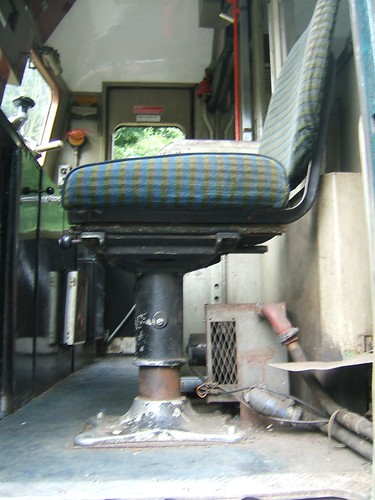
Detail of the driver's adjustable seat.
I often say '90% of a driver's attention should be focussed on the line ahead'. We can debate the exact percentage but keeping a good lookout is vitally important. The windows across the full width of the DMU cab give a panoramic view down the line very welcome to steam drivers brought up on leaning out of the cab to get reasonable sightlines around the front of the boiler. Provided the blinds at the rear of the DMU cab are raised, the passengers, too, can enjoy the view of the route ahead. The blinds were provided, of course, for use at night when the lights in the passenger compartment would otherwise damage the driver's night vision. More modern designs of diesel railcar reverted to solid walls between passengers and cab.
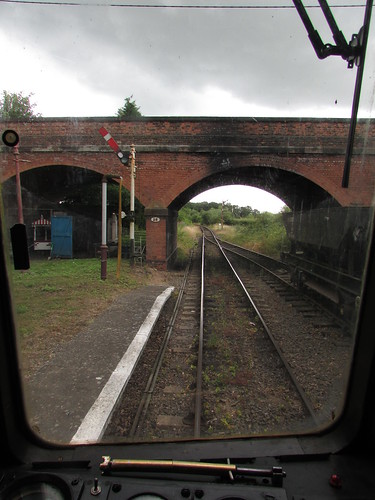
DMU Days at the Battlefield Line: Driver's view leaving Market Bosworth for Shackerstone.
On a steam-hauled train, to give the driver any chance of watching the line ahead, it's a requirement that the locomotive is a the front of the train (except where special arrangements are made called 'push-pull' or 'auto' trains). This means that, at each and of the line, there's a period of furious activity where the locomotive is uncoupled from the coaches, shunted to the other end of the train and re-coupled. On DMU, a driving cab is provided at each end of the train so that, at the end of the line, it's only necessary for the driver to 'close' what had been the leading cab, move to the other end of the train and 'open' what had been the 'back cab' so as to become the leading cab. The business of 'closing' and 'opening' cabs involves the transfer of an electrical master key and removable handles to control the final drive and braking systems.
Although the supply of coal carried by a steam locomotive is normally arranged to suffice for a whole day, the water supply (which is boiled to produce steam, used to impel a piston up and down a cylinder producing useful work and then discharged as exhaust steam from the chimney) often requires replenishment a number of times a day. By contrast, a DMU may be able to run for a number of days before the diesel fuel tanks require topping-up and water (used to cool the diesel engines, as in a car) is recirculated.
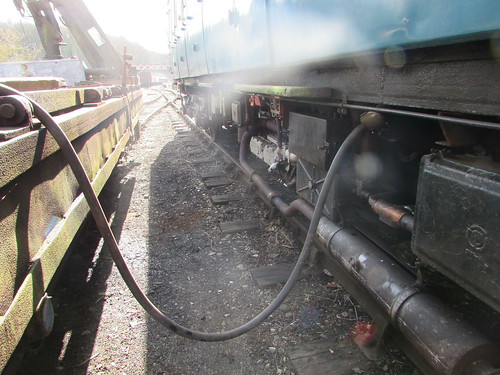 Refuelling the DMU at Shackerstone.
Refuelling the DMU at Shackerstone.
On a DMU, the driving controls, instruments and indications are laid out on the desk in front of the driver in a reasonably ergonomic manner unheard of on steam locomotives although Riddles, in designing the British Railways 'Standard' steam locomotives, attempted a convenient layout.
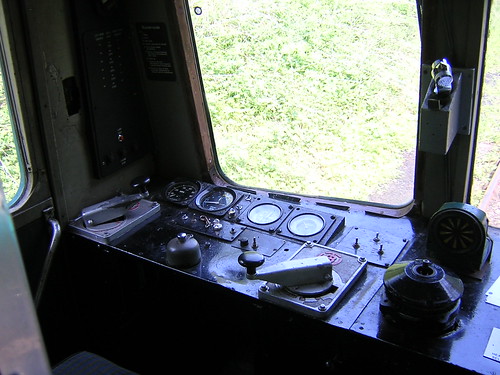
The driving controls, instruments and indications are neatly laid out on the desk in front of the driver.
Drivers also appreciated the 'power on demand' nature of the DMU. With steam traction, the power available to work the train depended upon many factors including time since last 'shopping', time since last boiler washout, quality of coal and, not least, attitude and competence of the fireman. In contrast, a DMU normally works as intended or doesn't work at all. That's a bit of a simplification but, in general, when a diesel driver opens the throttle, the power will flow, giving the driver a feeling of confidence that the job will go well.
But perhaps the best feature of working on a DMU is the opportunity to meet passengers. Many passengers seek out a seat in the leading coach where they can see the line ahead and watch the driver at work. In stations, passengers (men, ladies and children) can often be seen studying the cab and may ask questions. When working on steam, although we always try to acknowledge anyone nearby, the workload involved hinted at above means that a protracted chat is rarely possible. In contrast, when working on a DMU there are better opportunities for passengers to take photographs of the driver's 'office' or to answer questions (admittedly at the risk of boring them to tears - 'too much information'). I never cease to be amazed at the interesting backgrounds and experiences of our visitors. And, at the end of the day, I'm not quite as shattered (or dirty) as after a steam 'turn'.
